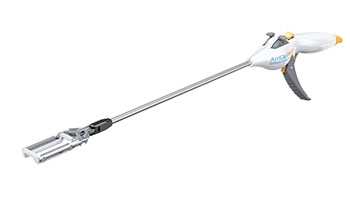Non-Piercing LAA Occluder Reduce Risk of Tissue Tear
By HospiMedica International staff writers
Posted on 12 Jul 2016
A novel clip system occludes the left atrial appendage (LAA) under direct visualization, in conjunction with other open cardiac surgical procedures.Posted on 12 Jul 2016
The AtriClip PRO2 device is designed to permanently occlude the LAA via a minimally invasive surgical (MIS) procedure in order to prevent blood from entering the trabeculated area of the LAA, known to be the source of over 95% of detected blood clots (thrombi) in patients with atrial fibrillation (AF). The PRO2 delivers consistent, atraumatic pressure via parallel titanium crossbars that do not crush or damage tissue. The clip has a woven polyester fabric covering to promote tissue in growth, achieving complete encapsulation in 180 days from implant, without risking erosion of adjacent structures.

Image: The AtriClip PRO2 device and LAA clip (Photo courtesy of AtriCure).
Features of the PRO2 system include a low-profile 25 cm rigid shaft applicator with an omnidirectional head and ±30° articulation for precise delivery; a quick deploy feature and an ambidextrous locking and trigger-style clip closing mechanism activated via handle-based active articulation levers; and a hoopless end effector to improve management of LAA occlusion. The AtriClip PRO2 device, available in four sizes (35, 40, 45, and 50mm), is a product of AtriCure (Mason, OH, USA), and has received the European Community CE mark of approval.
“The addition of the AtriClip PRO2 device has expanded the left atrial appendage product offerings and now provides an ambidextrous locking and trigger-style clip closing mechanism, handle-based active articulation levers, and a hoopless end effector,” said Michael Carrel, President and CEO of AtriCure. “These features have improved the ease of use and time it takes to manage the left atrial appendage.”
The LAA is a small, ear-shaped sac in the muscle wall of the left atrium. In normal hearts, the heart contracts with each heartbeat, and the blood in the left atrium and LAA is squeezed out into the left ventricle. When a patient has AF, the chaotic impulses do not give the atria time to contract, and blood collects and can form clots in the LAA and atria. The LAA is thought to be the source of more than 90% of stroke-causing blood clots that come from the heart in non-valvular AF patients.
Related Links:
AtriCure














